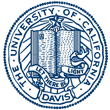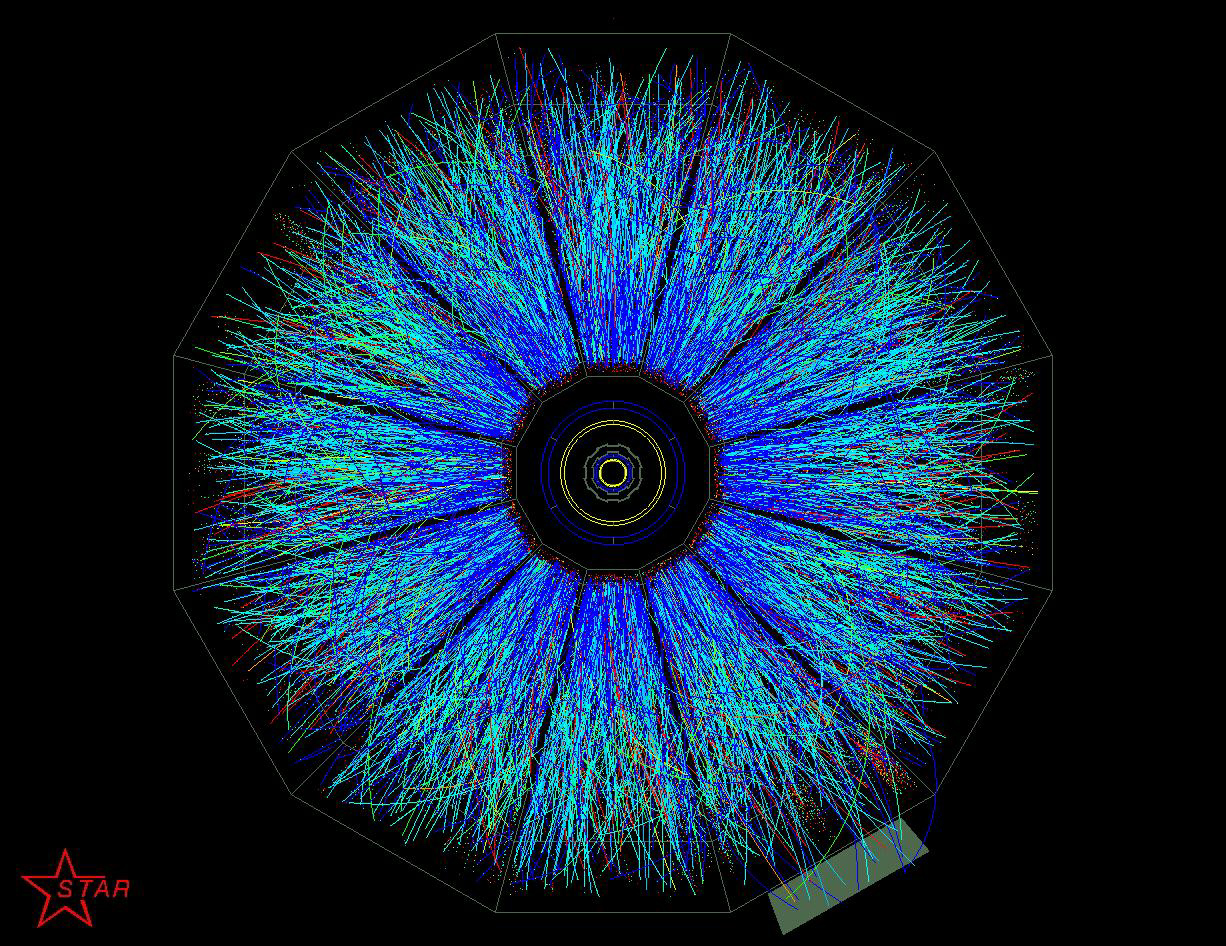
This REU program was funded through NSF PHY-0649297.


(Students' names link to their final papers.)
Condensed Matter Experiment
Magnetic moments in ferromagnets align within regions known as domains. Each domain has its own orientation, so the magnetic fields from different domains partly cancel each other, reducing the overall magnetic energy. Since distances of typically a few nanometers separate the domains, a ferromagnet that itself is only a few nanometers wide must develop a different type of structure. Peter Greene (University of Washington; advisor Kai Liu) used sputtering and electrodeposition to fabricate nanowires with alternating segments of cobalt and copper. He then used vibrating sample magnetometry and magnetoresistance measurements to study how the magnetization of the wires changes from one orientation to another when an external magnetic field is applied. He found differences from the behavior of isolated disks, demonstrating the importance of the interlayer coupling in the wires. A next step is to use nested hysteresis loops to determine the magnetic configuration within the wire. Peter presented his work at the California APS Section Meeting, winning the second prize for an undergraduate presentation.
David de Guzman (Cosumnes River College; advisor Rena Zieve) followed up measurements another undergraduate had made during the schoolyear which showed that a granular pile containing a mixture of two grain shapes was less stable than a pile with either of the two shapes individually. The previous student used a particular pair of shapes, and David extended the work to other mixtures, finding a similar effect. David created the shapes by welding spherical ball bearings together. He then filmed avalanches in a rotating drum, noting the angle the free surface reached before each avalanche. He also improved the analysis software, adding routines to identify grain locations from the filmed images and make their coordinates available for further processing. Hopefully a detailed knowledge of the grain configuration will help in understanding why mixtures avalanche more easily than homogeneous piles.
Silver atoms on a germanium surface appear to form different types of patterns depending on the covering density of the silver atoms. Anna Rosen (Los Angeles Pierce College; advisor Shirley Chiang) used a scanning tunneling microscope (STM) with atomic resolution to investigate this behavior. Because any contaminants on the surface could change the arrangement of silver atoms, obtaining an atomically clean surface was crucial. This required various cycles of heating and bombarding with argon ions, all after the sample was mounted in the ultra-high-vacuum chamber that housed the STM. These operations involved moving the sample within the chamber, which proved difficult. Anna worked on improvements to the sample holder to reduce the chance of breaking the sample during or just after the cleaning process.
Mark Wellons (College of Wooster; advisor Rena Zieve) worked on a study of vortex stability in superfluid helium. The experiments were to test what topography is most favorable for a vortex: a flat surface, or one curved inward or outward. Mark worked on the many-step process of assembling and testing experimental cells. He also installed data acquisition boards and software on a new computer and ported the lab's existing data acquisition programs from Windows to Linux. Unfortunately, he was not able to make measurements himself. Until the final week of the program, all the cells tested had problems with leaks, electrical shorts, or insufficient tension in the fine wire used to detect the vortex.
Condensed Matter Theory
In superconductivity, electrons form pairs which then condense into the superconducting ground state. Because of the pairing, the condensation does not violate the Pauli exclusion principle, which applies only to single-particle states. In most known superconductors the electrons in each pair have opposite spin, so to maximize pairing equal numbers of spin-up and spin-down electrons must be present. Miriam Huntley (Massachusetts Institute of Technology; advisor Richard Scalettar) looked at what states arise in a system where imbalanced spin populations make complete pairing impossible. She used Quantum Monte Carlo techniques to analyze a Hubbard model, focusing on regimes that may correspond to experimental conditions in optical traps. She found evidence for a Fulde-Ferrell-Larkin-Ovchinnikov phase, where the strength of the superconductivity varies spatially through the sample.
Computational Complex Systems
Rebecca Morrison (Scripps College; advisor Jim Crutchfield) worked on algorithms that allow robots to learn about their environment and use the knowledge to improve their performance of a given task. Such algorithms could be useful, for example, for robots exploring unfamiliar terrain undersea, in caves, or on other planets. Two issues are how a robot can make decisions that allow it to gain new information, and how robots share information with each other. Rebecca debugged and extended a computer simulation of multiple robots that search for the longest paths in a room that avoid running into the walls. She solved various preliminary steps, such as making sure the simulated robots never overlap each other or move through the walls. Adding the learning process itself is the next step.
Biological Physics
Prions are misfolded proteins that damage the brain, causing various fatal diseases, including "mad cow" disease. Through a mechanism not yet understood, prions can replicate by converting normally folded proteins into the abnormal form. This leads to exponential growth in the number of prions. One question is why the growth rate happens to lie in the range that we can see, where the incubation period from infection to onset of symptoms can be many years. With a faster growth rate, prions would multiply so quickly that victims would die almost immediately. With a slower growth rate, nearly everyone would die of other causes before exhibiting prion disease symptoms. Evan Olson (Central College; advisor Daniel Cox) worked on a model for how prions lead other proteins to misfold. His programs consistently found exponential growth. The next step is quantitative comparisons with data to see what parameters tune the growth rate to the correct magnitude.
Jamy Moreno (Richard Stockton College of New Jersey; advisor Xiangdong Zhu) worked on the Oblique-Incidence Reflectivity Difference (OI-RD) microscope that Professor Zhu's group is developing. OI-RD detects chemical interactions through polarization changes in reflected light. The technique is non-invasive, with no chemical labelling required, and also has potential for extremely high throughput. Jamy worked on testing the procedures for setting up a 6000-compound library of molecules in a microarray of tiny wells. By using some compounds with known reactivity and finding the expected reactions in the resulting microarray, she showed the effectiveness of the procedures for creating the molecules and placing them in the wells. She found an additional reaction of some chemicals with the glass surface of the microarray, which must be better understood before using the technique. Ultimately chemical reactions will be measured for the entire library.
High Energy Theory
When the Large Hadron Collider (LHC) begins operation next year at higher energies than any previous accelerators, physicists expect to observe new particles and decay processes. One popular extension to the Standard Model of particle physics, supersymmetry, predicts new particles called neutralinos that will interact too weakly with the detectors to leave a direct signature. Instead, they will be found through "missing momentum," or lack of momentum conservation among the particles observed in a collision. Neutralinos are particularly intriguing as a possible candidate for dark matter, the invisible extra mass in the universe that affects the motion of galaxies. Dalit Engelhardt (Boston University; advisor Hsin-Chia Cheng) studied collisions that lead to six or eight product particles, two of them invisible. She worked on the implications of the many resulting momentum and energy conservation equations, doing the linear algebra in part analytically and in part with a computer package. She also wrote code to generate, analyze, and catalog possible collisions. Since the generated events include experimental realities such as imperfect resolution of observed momenta by the detector, the work shows how particles with certain masses will appear in LHC data.
General relativity and quantum mechanics have both stood up to experimental testing: relativity in astronomical observations, and quantum mechanics at atomic length scales. Reconciling the two into a single theory that includes both behaviors has been an outstanding problem for decades. Jun Zhang (Cornell University; advisor Steve Carlip) did numerical work on one approach to the unification problem, causal dynamical triangulation. The theory involves path integrals over possible evolutions of spacetime. Working in two spatial plus one time dimension, Jun wrote code to triangulate spacetime and describe its development.
Nuclear Physics
Colliding heavy ions at high energies creates a quark-gluon plasma (QGP), mimicking conditions a fraction of a second after the Big Bang. Evan Sangaline (Bard College; advisors Manuel Calderon de la Barca Sanchez and Daniel Cebra) studied the anisotropy in the paths of the reaction particles, which is mass-dependent and yields information on the QGP. Evan investigated how to extract the reaction plane from the data and tried to make corrections for the position and resolution of the detectors. He is continuing the work during the schoolyear, remaining in contact with the Davis group through e-mail and weekly videoconferences.
Cosmology
In strong gravitational lensing, light from a distant source bends as it passes near a large mass. In some cases telescopes detect multiple images of a single object, if light originally radiated in different directions gets focused toward earth. The time delay between these images can yield a value of the Hubble constant, which measures the expansion rate of the universe. However, extracting the Hubble constant requires knowledge of the mass distribution within the lensing galaxy. Recent measurements suggest that galaxies with nearby companion galaxies may have a steeper mass distribution. Allison Arpin (Elon College; advisor Chris Fassnacht) tested whether such a trend in mass distribution affects Hubble constant measurements. Her analysis did not find an effect, but further work needs to be done in identifying companion galaxies; galaxies that appear close in the field of view may still be far apart if their distances from earth vary greatly.